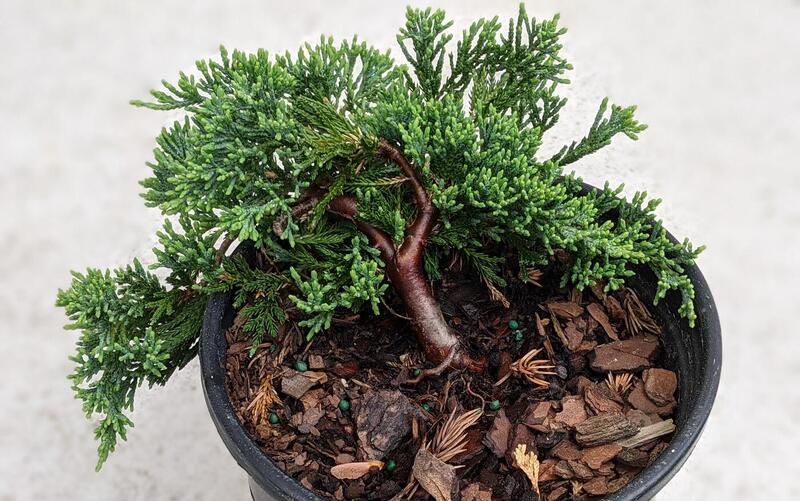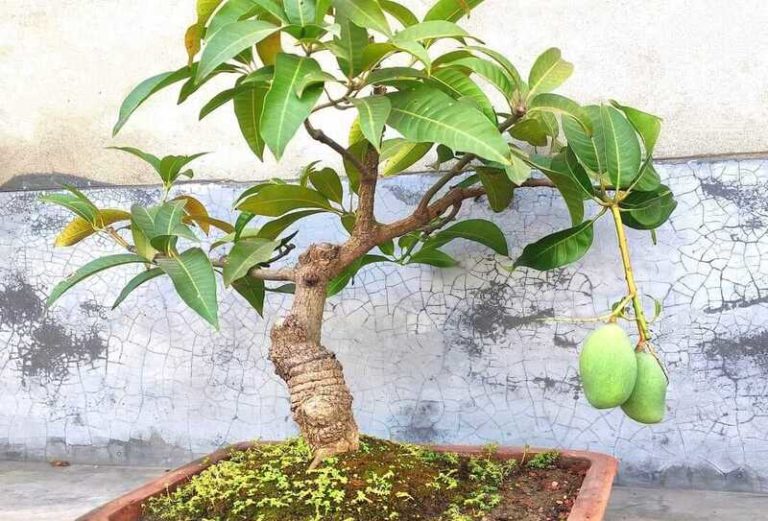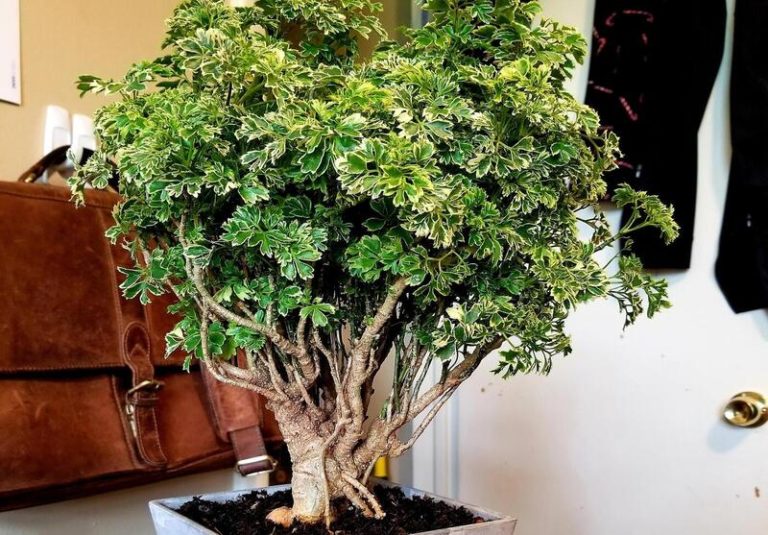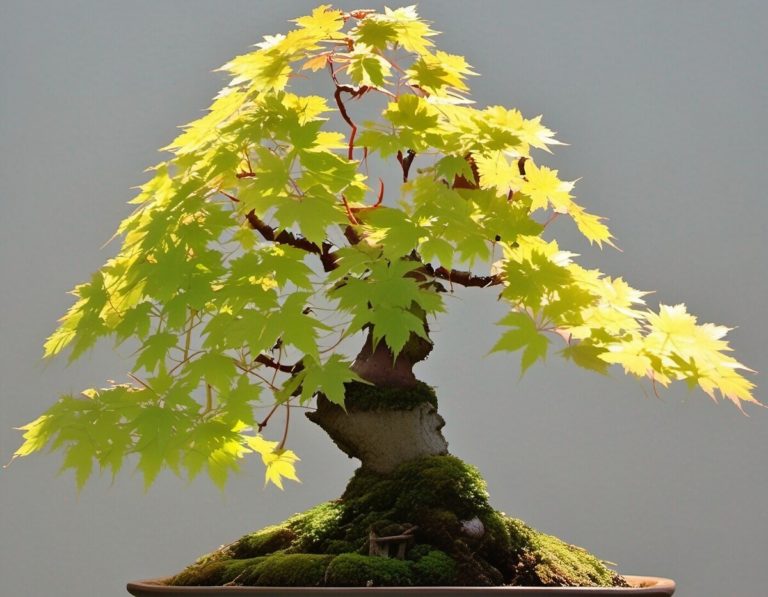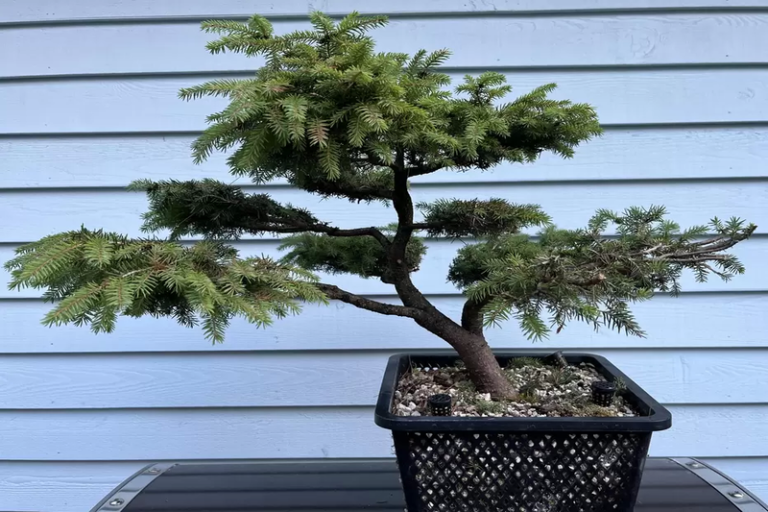Blue Rug Juniper Bonsai: Cultivating a Living Masterpiece in Your Garden
Bonsai trees are tiny versions of full-grown trees that have won the hearts of many gardeners. One such fascinating bonsai is the blue rug juniper tree. In this article, we will look into the world of blue rug juniper bonsai, learn about its unique qualities, and find out how to care for and grow this beautiful tree.
What is a Blue Rug Juniper Bonsai?
A Blue Rug Juniper Bonsai is a small tree created from the Blue Rug Juniper plant. It is a popular bonsai variety known for its compact size, blue-green foliage, and spreading branches. Through pruning and training techniques, the Blue Rug Juniper Bonsai is shaped into a miniature tree, offering a sense of tranquility and natural beauty. It is highly valued by bonsai enthusiasts for its unique color and ability to thrive in different climates.
History and Origins of the Blue Rug Juniper Bonsai
The history and origins of the Blue Rug Juniper Bonsai can be traced back to the Blue Rug Juniper plant itself. The Blue Rug Juniper (Juniperus horizontalis ‘Wiltonii’) is a cultivar of the native North American plant, Juniperus horizontalis.
The Blue Rug Juniper plant was first discovered and introduced into cultivation in the mid-20th century. Its unique growth habit and striking blue-green foliage caught the attention of horticulturists and bonsai enthusiasts. Recognizing its potential as a bonsai tree, efforts were made to cultivate and train the Blue Rug Juniper into a miniature form.
Bonsai, the art of growing and shaping miniature trees, has a long history originating in China and later popularized in Japan. The practice of bonsai involves meticulously pruning, wiring, and training a tree to create a miniature version that embodies the essence of a full-grown tree in nature.
The Blue Rug Juniper Bonsai emerged as a popular bonsai variety due to its low-growing habit, dense branching structure, and unique blue foliage. Its ability to thrive in a variety of climates further added to its appeal.
Over time, bonsai enthusiasts and experts refined the techniques for cultivating and shaping Blue Rug Juniper Bonsai trees, resulting in the creation of stunning miniature trees that evoke a sense of tranquility and natural beauty.
Today, the Blue Rug Juniper Bonsai continues to be a cherished and sought-after bonsai variety, admired for its compact size, striking color, and the artistry involved in its cultivation. Its origins as a cultivar of the Blue Rug Juniper plant and the rich history of bonsai as an art form have contributed to its popularity and enduring appeal.
Blue Rug Juniper Bonsai and Their Symbolism
Blue Rug Juniper Bonsai, like all bonsai trees, holds symbolism and meaning in various cultures. Here are some common symbolic associations and meanings associated with Blue Rug Juniper Bonsai:
- Harmony: Bonsai trees, including the Blue Rug Juniper Bonsai, symbolize harmony and balance. The careful cultivation and shaping of the tree represent the harmony between humans and nature.
- Patience: Bonsai cultivation requires patience and dedication. The slow growth and meticulous care of the Blue Rug Juniper Bonsai symbolize the value of patience in life.
- Resilience: The Blue Rug Juniper is known for its ability to thrive in various climates and conditions. This resilience is often associated with the bonsai tree, representing the strength to endure and overcome challenges.
- Tranquility: The presence of a Blue Rug Juniper Bonsai brings a sense of tranquility and serenity to its surroundings. The miniature tree evokes a peaceful and calming ambiance.
- Connection to Nature: Bonsai trees, including the Blue Rug Juniper Bonsai, are seen as a way to bring nature into our living spaces. They remind us of our connection to the natural world and the importance of preserving and appreciating its beauty.
- Reflection and Meditation: Bonsai cultivation often involves quiet contemplation and mindfulness. The presence of a Blue Rug Juniper Bonsai can serve as a focal point for meditation and reflection.
- Symbol of Beauty: The Blue Rug Juniper Bonsai’s compact form, vibrant blue-green foliage, and artistic aesthetics make it a symbol of beauty and artistry.
- Longevity: Bonsai trees have the potential to live for many years with proper care. The Blue Rug Juniper Bonsai represents longevity and the appreciation of the passing of time.
These symbolic associations may vary across different cultures and personal interpretations. Ultimately, the symbolism of a Blue Rug Juniper Bonsai can be a personal and meaningful reflection of the connection between nature, aesthetics, and our inner selves.
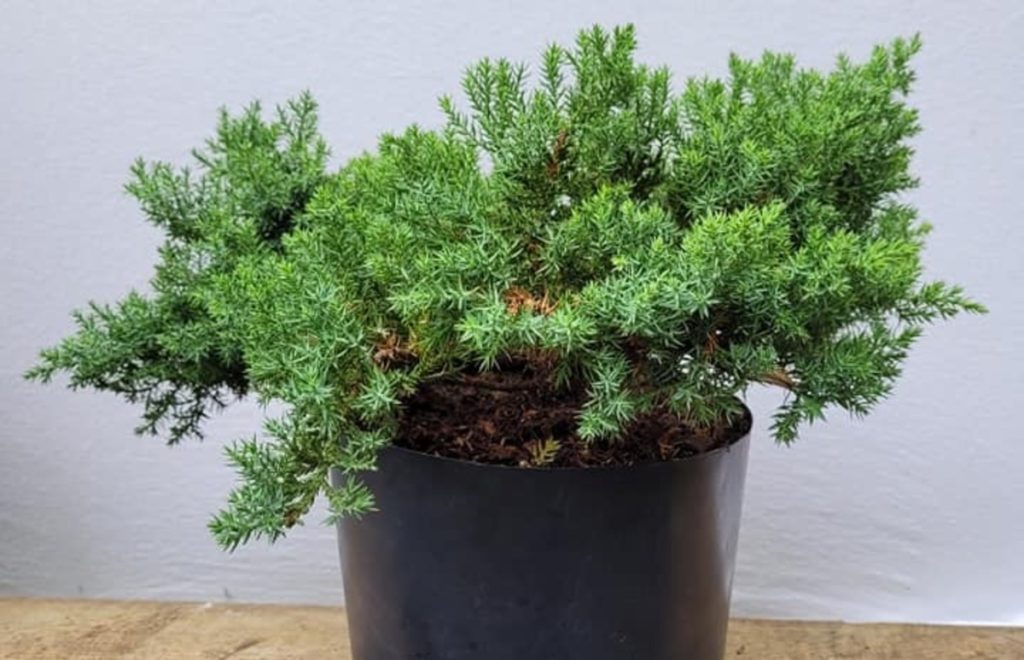
Characteristics of the Blue Rug Juniper Bonsai
The Blue Rug Juniper Bonsai possesses several distinct characteristics that contribute to its appeal and uniqueness. Here are the key features of the Blue Rug Juniper Bonsai:
Compact Size: Blue Rug Juniper Bonsai is known for being small and compact. This makes it a great choice for bonsai fans who don’t have much room or who like small trees.
Spreading Habit: The branches of the Blue Rug Juniper Bonsai have a low-growing and spreading habit. This growth pattern gives the bonsai a visually appealing and balanced appearance.
Blue-Green Foliage: The beautiful blue-green leaves on the Blue Rug Juniper Bonsai are one of the things that make it stand out. The plant has soft, scale-like tips that are a blue color. This makes it different from many other bonsai types.
Drought Tolerance: Blue Rug Juniper Bonsai is known for its exceptional tolerance to drought conditions. This makes it a suitable choice for bonsai enthusiasts living in arid regions or those who prefer a low-maintenance tree.
Evergreen Nature: Like its parent plant, the Blue Rug Juniper Bonsai retains its foliage throughout the year, making it an evergreen bonsai. This attribute ensures that the bonsai maintains its vibrant appearance and adds beauty to the surroundings, even during the winter months.
Adaptability: Blue Rug Juniper Bonsai is adaptable to various climates and can tolerate both hot and cold weather conditions. It can thrive in full sun to partial shade, making it versatile in terms of placement options.
Textured Bark: As the Blue Rug Juniper Bonsai matures, its bark develops an attractive and textured appearance, adding to its aesthetic appeal.
Low Maintenance: Blue Rug Juniper Bonsai is generally considered a low-maintenance bonsai tree. It requires minimal pruning and can withstand periods of neglect without significant harm.
These characteristics make the Blue Rug Juniper Bonsai a popular choice among bonsai enthusiasts. Its compact size, blue-green foliage, adaptability, and low-maintenance nature contribute to its overall charm and desirability as a bonsai tree.
Types of Blue Rug Juniper Bonsai
While there is primarily one type of Blue Rug Juniper Bonsai, which is derived from the Blue Rug Juniper plant (Juniperus horizontalis ‘Wiltonii’), there are different variations and cultivars within the Blue Rug Juniper species that can be used for bonsai. These variations offer slight differences in characteristics while still maintaining the overall appeal of the Blue Rug Juniper Bonsai. Here are a few notable types:
1. Juniperus horizontalis ‘Blue Rug’: This is the standard variety of the Blue Rug Juniper Bonsai. It features low-growing, spreading branches and dense blue-green foliage, creating a compact and visually appealing bonsai tree.
2. Juniperus horizontalis ‘Wiltonii Nana’: This cultivar is a dwarf form of the Blue Rug Juniper. It has a more compact growth habit, making it even smaller in size and well-suited for bonsai cultivation.
3. Juniperus horizontalis ‘Limeglow’: This variation of Blue Rug Juniper Bonsai features lime-green foliage rather than the typical blue-green color. It adds a unique and vibrant touch to the bonsai display.
4. Juniperus horizontalis ‘Andorra Compacta’: While not specifically named as a Blue Rug Juniper, this cultivar shares similar characteristics. It is a low-growing, spreading juniper with blue-green foliage, suitable for bonsai training.
These are a few examples of Blue Rug Juniper Bonsai variations and cultivars that offer slight differences in color, growth habit, or size while still retaining the overall appeal and characteristics of the Blue Rug Juniper species. Each type can bring its own charm and uniqueness to a bonsai collection.
How to Grow a Blue Rug Juniper Bonsai
To grow a Blue Rug Juniper Bonsai, you need to pay close attention to its needs and use the right techniques for growing plants. Here’s how to grow a Blue Rug Juniper Bonsai step by step:
Selection of a Healthy Tree:
- Choose a healthy Blue Rug Juniper Bonsai tree from a reputable nursery or bonsai supplier.
- Look for a tree with vibrant blue-green foliage and well-developed branches.
Suitable Pot and Soil:
- Select a bonsai pot that is appropriate in size, allowing for the root system’s growth.
- Ensure the pot has drainage holes to prevent waterlogging.
- Use well-draining bonsai soil or a mixture of Akadama, pumice, and lava rock to provide adequate drainage.
Positioning and Sunlight:
- Place the Blue Rug Juniper Bonsai in a sunny location that receives at least 6 hours of direct sunlight daily.
- Avoid extreme heat or cold drafts.
Watering:
- Water the bonsai thoroughly when the top inch of soil feels slightly dry.
- Avoid overwatering, as Blue Rug Juniper Bonsai prefers a slightly drier soil compared to other bonsai varieties.
- Adjust watering frequency based on the climate and environmental conditions.
Pruning and Shaping:
- Regularly prune the Blue Rug Juniper Bonsai to maintain its compact form and encourage branching.
- Use sharp bonsai pruning shears to remove any dead, damaged, or unruly branches.
- Shape the bonsai gradually over time, keeping in mind the desired form and aesthetics.
Wiring and Styling:
- Use bonsai training wires to gently shape the branches into the desired position.
- Be careful not to apply excessive pressure that may damage the branches.
- Wiring is best done during the tree’s dormant period in early spring.
Fertilization:
- Apply a balanced, slow-release bonsai fertilizer during the growing season (spring to fall).
- Follow the manufacturer’s instructions for proper dosage and frequency.
- Avoid fertilizing during winter or when the tree is experiencing stress.
Protection from Extreme Weather:
- Blue Rug Juniper Bonsai is generally hardy, but protection may be needed during extreme cold or heat.
- Shield the tree from frost, strong winds, or scorching sun, depending on your climate.
Regular Maintenance:
- Check the bonsai regularly for pests, diseases, or any signs of stress.
- Remove any weeds or unwanted growth around the bonsai.
- Repot the Blue Rug Juniper Bonsai every 2-3 years to refresh the soil and prevent root congestion.
Patience and Observation:
- Growing a Blue Rug Juniper Bonsai requires patience and observation.
- Monitor the tree’s health, growth, and overall aesthetics.
- Make adjustments in care and maintenance as needed.
Remember, growing a Blue Rug Juniper Bonsai is an ongoing process that requires consistent care and attention. By providing the right conditions and following these guidelines, you can enjoy the beauty and serenity of your Blue Rug Juniper Bonsai as it matures and develops over time.
Benefits of the Blue Rug Juniper Bonsai
The Blue Rug Juniper Bonsai offers several benefits to bonsai enthusiasts and those who appreciate its unique characteristics. Here are some of the key benefits of having a Blue Rug Juniper Bonsai:
Aesthetically Pleasing: The Blue Rug Juniper Bonsai’s compact size, spreading branches, and beautiful blue-green foliage create a visually appealing miniature tree. It adds a touch of natural beauty and enhances the aesthetics of any space, whether indoors or outdoors.
Space Efficiency: Due to its small size and low-growing habit, the Blue Rug Juniper Bonsai is an excellent choice for those with limited space. It can be displayed on tabletops, shelves, or small outdoor areas, making it a versatile option for bonsai enthusiasts in urban settings.
Low Maintenance: The Blue Rug Juniper Bonsai requires less care than some other types of bonsai. It can survive periods of drought and being ignored without much harm. This makes it a great choice for people who are just starting out with bonsai or who have busy lives and can’t spend a lot of time taking care of them.
Hardy and Adaptable: Blue Rug Juniper Bonsai is well-known for its resilience and adaptability to a variety of conditions. It can withstand both hot and cold weather conditions, making it perfect for a variety of applications. This resilience guarantees that the bonsai may develop and remain healthy with adequate care.
Stress Reduction and Relaxation: The presence of a Blue Rug Juniper Bonsai can contribute to stress reduction and relaxation. Bonsai cultivation itself can be a meditative and calming activity, and the miniature tree brings a sense of tranquility and nature into the living space, creating a serene atmosphere.
Symbolism and Meaning:As with all bonsai trees, the Blue Rug Juniper Bonsai represents harmony, equilibrium, and a connection to nature. It can serve as a reminder of the significance of perseverance, resiliency, and appreciating the natural world’s majesty.
Educational and Therapeutic Value: How to take care of and grow a blue rug Bonsai made from juniper trees can be both informative and relaxing. It’s a chance to learn about gardening, bonsai, and the careful balance of caring for plants. Taking care of a live tree can also help you develop a sense of duty, become more aware, and grow as a person.
Overall, the Blue Rug Juniper Bonsai offers a range of benefits, including aesthetic appeal, space efficiency, low maintenance, adaptability, stress reduction, symbolic value, and educational opportunities. It is a delightful addition to any bonsai collection or living space, bringing natural beauty and a sense of tranquility.
Displaying and Showcasing the Blue Rug Juniper Bonsai
Displaying and showcasing the Blue Rug Juniper Bonsai requires careful consideration to enhance its beauty and create an appealing presentation. Here are some tips on how to display and showcase your Blue Rug Juniper Bonsai:
1. Choice of Display Area: Select an appropriate location to showcase your Blue Rug Juniper Bonsai. Consider the lighting conditions, temperature, and overall aesthetics of the space. Indoor or outdoor settings can work well, as long as the tree’s requirements are met.
2. Bonsai Stand or Table: To elevate and highlight the aesthetic attractiveness of your Blue Rug Juniper Bonsai, place it on a bonsai stand or a professionally built bonsai table. The support can be built of wood, metal, or stone to match the overall look of the bonsai.
3. Positioning and Balance: Ensure the Blue Rug Juniper Bonsai is positioned in a way that provides a balanced and pleasing composition. Consider the tree’s natural growth pattern, branch structure, and overall form when arranging it on the display stand. Aim for a harmonious and visually appealing arrangement.
4. Container Selection: Choose an appropriate bonsai pot or container that complements the tree’s size, shape, and color. Traditional ceramic pots are commonly used, but you can also explore other materials like clay or stone. Ensure the pot’s style and color enhance the overall presentation of the bonsai.
5. Accent Elements: Consider adding accent elements such as small rocks, moss, or miniature figurines to enhance the display. These elements can create a sense of scale, provide visual interest, or mimic a natural setting.
6. Pruning and Maintenance: Regularly prune and maintain your Blue Rug Juniper Bonsai to preserve its compact form and ensure it remains aesthetically pleasing. Remove any dead or unsightly branches, and trim foliage as needed to maintain balance and proportion.
7. Rotating the Display: To promote even growth and prevent one-sided development, periodically rotate the bonsai on its display stand. This allows all sides of the tree to receive adequate sunlight and promotes balanced growth.
8. Protection and Care: Take steps to protect your Blue Rug Juniper Bonsai from extreme weather conditions, pests, and diseases. Shield it from frost, excessive heat, strong winds, or heavy rains, depending on your climate. Regularly inspect the tree for any signs of stress or issues that may require attention.
9. Showcasing at Bonsai Exhibitions: If you wish to showcase your Blue Rug Juniper Bonsai at bonsai exhibitions or shows, ensure it is well-prepared. Keep it healthy and groomed, and follow any specific guidelines or regulations provided by the event organizers.
Remember that the art of displaying and showcasing a Blue Rug Juniper Bonsai is a creative process, and you can adapt these tips based on your personal taste and the available space. The goal is to highlight the tree’s natural beauty while maintaining its health and vitality.
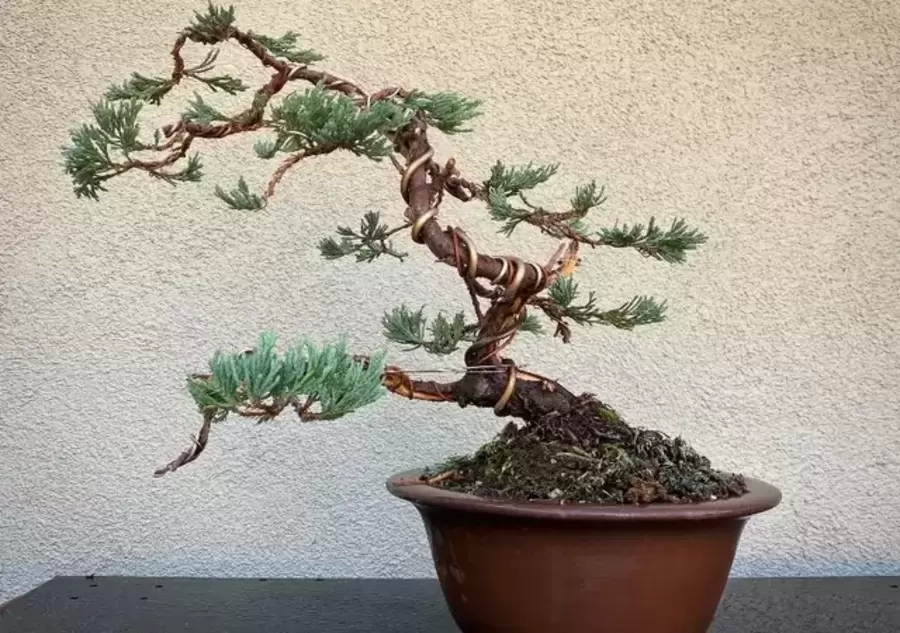
Styling and Design of a Blue Rug Juniper Bonsai
Styling and designing a Blue Rug Juniper Bonsai involves shaping the tree’s branches and foliage to create a visually pleasing and balanced composition. Here are some key considerations and techniques for styling and designing your Blue Rug Juniper Bonsai:
Research and Study: Before you begin styling your Blue Rug Juniper Bonsai, it is essential to research the species and understand its natural growth habits. Study the characteristics of mature Blue Rug Juniper trees to gain insight into their overall form, branch structure, and foliage arrangement.
Desired Style: Determine the desired style for your Blue Rug Juniper Bonsai. Common bonsai styles include formal upright, informal upright, slanting, cascade, and windswept. Each style has its unique aesthetic and principles of branch and foliage placement.
Branch Selection: Identify the primary branches that will form the basic structure of the bonsai. Choose branches that have good movement, taper, and are well-positioned on the trunk. Remove any unnecessary branches or ones that detract from the desired design.
Wiring: Wiring is a crucial technique in bonsai styling. Use bonsai training wires to gently bend and position branches to achieve the desired shape. Start with thicker wire at the base of the branch and gradually transition to a thinner wire as you move toward the tip. Be careful not to apply excessive pressure that may damage or snap the branches.
Branch Placement: Consider the placement of branches to create depth, balance, and a natural appearance. Branches should alternate in direction and size, with shorter branches closer to the trunk and longer branches toward the outer edges. Avoid overcrowding branches and allow space for foliage growth and airflow.
Foliage Pruning: Prune the foliage of the Blue Rug Juniper Bonsai to refine its shape and density. Remove any excessive or unbalanced foliage to maintain a more compact and visually appealing silhouette. Prune branches and foliage in a way that enhances the overall design and maintains the desired aesthetic.
Jin and Shari: Jin refers to dead or partially dead branches, while Shari refers to the stripped or exposed areas of the trunk. Incorporate Jin and Shari into the design of your Blue Rug Juniper Bonsai to create a sense of age and character. Use bonsai carving tools to carefully remove bark and shape these features.
Patience and Iteration: Styling and designing a Blue Rug Juniper Bonsai is an iterative process that requires patience and observation. Take your time and step back regularly to evaluate the tree’s overall appearance. Make adjustments as needed, keeping in mind the desired style and design principles.
Regular Maintenance: Once you have styled and designed your Blue Rug Juniper Bonsai, regular maintenance is crucial to preserve its shape and health. Continuously monitor the tree, prune as necessary, and make minor adjustments to branch positioning and wiring as the tree grows.
Remember that bonsai styling is an art form, and the design of your Blue Rug Juniper Bonsai should reflect your personal taste and artistic expression. It takes time and practice to develop your skills and create a visually stunning bonsai tree. Enjoy the process, and allow your creativity to shine through in the design of your Blue Rug Juniper Bonsai.
How to Care for and Maintain a Blue Rug Juniper Bonsai
Caring for and maintaining a Blue Rug Juniper Bonsai is essential to ensure its health, vitality, and aesthetic appeal. Here are some key care guidelines for your Blue Rug Juniper Bonsai:
1. Watering:
Check the moisture level of the soil regularly. Water the bonsai when the top inch of soil feels slightly dry.
- Avoid overwatering, as Blue Rug Juniper Bonsai prefers a slightly drier soil compared to other bonsai varieties.
- Water thoroughly, ensuring that water reaches the entire root system.
- Adjust the frequency of watering based on the climate, season, and environmental conditions.
2. Sunlight and Positioning:
- Blue Rug Juniper Bonsai thrives in full sun to partial shade.
- Place your bonsai in a location that receives at least 6 hours of direct sunlight daily.
- Protect the bonsai from extreme heat or cold drafts.
3. Fertilization:
- Apply a balanced, slow-release bonsai fertilizer during the growing season (spring to fall).
- Follow the manufacturer’s instructions for proper dosage and frequency.
- Avoid fertilizing during winter or when the tree is experiencing stress.
4. Pruning and Shaping:
- Regularly prune your Blue Rug Juniper Bonsai to maintain its compact form and encourage branching.
- Use sharp bonsai pruning shears to remove any dead, damaged, or unruly branches.
- Prune selectively to maintain the tree’s desired shape and aesthetic appeal.
- Pruning can be done throughout the year, but avoid heavy pruning during extreme weather conditions.
5. Wiring and Styling:
- Use bonsai training wires to gently shape the branches and create the desired design.
- Be cautious not to apply excessive pressure that may damage the branches.
- Wiring is best done during the tree’s dormant period in early spring.
6. Repotting:
Blue Rug Juniper Bonsai generally needs repotting every 2-3 years to refresh the soil and prevent root congestion.
- Repot the bonsai during the early spring before new growth begins.
- Trim some of the roots during repotting to maintain a balanced root-to-foliage ratio.
- Use well-draining bonsai soil and ensure the pot has proper drainage holes.
7. Protection from Extreme Weather:
- Blue Rug Juniper Bonsai is generally hardy, but protection may be needed during extreme cold or heat.
- Shield the tree from frost, strong winds, or scorching sun, depending on your climate.
8. Pest and Disease Control:
- Regularly inspect your bonsai for any signs of pests, such as spider mites or aphids.
- If detected, take appropriate measures to control the infestation using organic or chemical methods.
- Ensure good airflow around the tree and maintain proper hygiene to prevent fungal diseases.
9. Regular Observation and Maintenance:
- Regularly observe your Blue Rug Juniper Bonsai for signs of stress, nutrient deficiencies, or other issues.
- Check for any wiring cutting into branches and remove or adjust as necessary.
- Remove any weeds or unwanted growth around the bonsai to reduce competition for nutrients and water.
By following these care guidelines and providing proper attention, your Blue Rug Juniper Bonsai can thrive and remain a beautiful and healthy addition to your bonsai collection. Remember to adapt your care routine based on the specific needs and environmental conditions of your bonsai.
Blue Rug Juniper Bonsai Care Sheet
| Aspect | Care Tips |
| Watering | Check soil moisture; water when the top inch is slightly dry. |
| Avoid overwatering; Blue Rug Juniper prefers slightly drier soil. | |
| Sunlight | Place in full sun to partial shade; requires at least 6 hours of direct sunlight daily. |
| Temperature | Hardy; can tolerate a wide range of temperatures. |
| Humidity | Can adapt to various humidity levels; doesn’t require high humidity. |
| Fertilization | Apply balanced, slow-release bonsai fertilizer during the growing season. |
| Follow manufacturer’s instructions for dosage and frequency. | |
| Pruning and Trimming | Regularly prune to maintain compact form and encourage branching. |
| Remove dead, damaged, or unruly branches with sharp bonsai pruning shears. | |
| Wiring and Styling | Use bonsai training wires for shaping, but avoid excessive pressure that may damage branches. |
| Best done during the dormant period in early spring. | |
| Repotting | Repot every 2-3 years during early spring before new growth starts. |
| Trim some roots and use well-draining bonsai soil with proper drainage holes. | |
| Pest and Disease Control | Regularly inspect for pests; take appropriate measures for control. |
| Maintain good airflow and hygiene to prevent fungal diseases. | |
| Winter Care | Shield from frost, strong winds, or scorching sun depending on climate. |
| Regular Maintenance | Observe for signs of stress, nutrient deficiencies, or other issues. |
| Check wiring to prevent cutting into branches; remove or adjust as needed. | |
| Remove weeds or unwanted growth around the bonsai. |
Remember, these care tips serve as general guidelines, and it’s important to consider your specific growing conditions and adapt the care routine accordingly. Regularly observe your Blue Rug Juniper Bonsai and make adjustments as needed to ensure its health and vitality.
Conclusion
Blue rug juniper bonsai is a captivating and rewarding tree to cultivate. By following the simple care and cultivation techniques discussed in this article, you can create and maintain a stunning bonsai that adds beauty and tranquility to your home or garden. Embrace the art of bonsai and enjoy the journey of nurturing and shaping your blue rug juniper bonsai tree.
FAQ:
Q: What is a Blue Rug Juniper Bonsai?
A: Blue Rug Juniper Bonsai is a miniature tree that is created through the art of bonsai cultivation. It is a variety of Juniperus horizontalis, known for its low-growing and spreading habit as well as its striking blue-green foliage.
Q: How big does a Blue Rug Juniper Bonsai grow?
A: Juniper Blue Rug Bonsai usually grows to be about 6–12 inches (15–30 cm) tall and 2–4 feet (60–120 cm) wide. It works well as a bonsai plant because it is small.
Q: Does Blue Rug Juniper Bonsai require a lot of sunlight?
A: Yes, the Blue Rug Juniper Bonsai thrives in full sun to partial shade. It requires at least 6 hours of direct sunlight daily to maintain its health and vibrant color.
Q: How often should I water my Blue Rug Juniper Bonsai?
A: Blue Rug Juniper Bonsai prefers slightly drier soil compared to other bonsai varieties. Check the top inch of soil and water it when it feels slightly dry. Avoid overwatering, as it can lead to root rot.
Q: Can I keep my Blue Rug Juniper Bonsai indoors?
A: While Blue Rug Juniper Bonsai can be kept indoors temporarily, it is best suited for outdoor cultivation. It requires ample sunlight and proper air circulation to thrive.
Q: How do I fertilize my Blue Rug Juniper Bonsai?
A: Use a balanced, slow-release bonsai fertilizer during the growing season (spring to fall). Follow the manufacturer’s instructions for the proper dosage and frequency. Avoid fertilizing during the winter or when the tree is stressed.
Q: How often should I prune my Blue Rug Juniper Bonsai?
A: Regular pruning is necessary to maintain the shape and compact form of your Blue Rug Juniper Bonsai. Prune as needed to remove dead or unruly branches. Avoid heavy pruning during extreme weather conditions.
Q: When should I repot my Blue Rug Juniper Bonsai?
A: Blue Rug Juniper Bonsai typically need repotting every 2-3 years, preferably in the early spring before new growth begins. Trim some of the roots and use well-draining bonsai soil.
Q: How do I protect my Blue Rug Juniper Bonsai during the winter?
A: Blue Rug Juniper Bonsai is generally hardy, but protection may be needed during extreme cold. Shield it from frost, strong winds, or scorching sun, depending on your climate.
Q: Are there any common pests or diseases that affect Blue Rug Juniper Bonsai?
A: Blue Rug Juniper Bonsai is generally resistant to pests and diseases. However, keep an eye out for spider mites, aphids, and fungal diseases. Regular inspections and appropriate measures can help control these issues.
Q: Can I grow Blue Rug Juniper Bonsai indoors?
A: Blue Rug Juniper Bonsai is best suited for outdoor cultivation due to its need for ample sunlight and proper air circulation. It can be brought indoors temporarily but should be placed back outside as soon as possible.
Q: How often should I wire and style my Blue Rug Juniper Bonsai?
A: Wiring and styling should be done during the tree’s dormant period in early spring. Avoid leaving the wires on for too long to prevent them from cutting into the branches.
Q: What are some common styling options for Blue Rug Juniper Bonsai?
A: Blue Rug Juniper Bonsai can be styled in various bonsai forms, including formal upright, informal upright, slanting, cascade, and windswept styles. The choice depends on your preferences and the tree’s natural characteristics.
Q: Can I trim the foliage of my Blue Rug Juniper Bonsai?
A: Yes, regular foliage pruning is necessary to maintain the desired shape and density of the bonsai. Remove any excessive or unbalanced foliage to promote a more compact and visually appealing silhouette.
Q: How do I protect my Blue Rug Juniper Bonsai from pests and diseases?
A: Regularly inspect your bonsai for signs of pests like spider mites or aphids. Control infestations using appropriate organic or chemical methods. Ensure good airflow and maintain proper hygiene to prevent fungal diseases.
Q: What should I do during the regular maintenance of my Blue Rug Juniper Bonsai?
A: Regularly observe your bonsai for signs of stress, nutrient deficiencies, or other issues. Check the wiring to prevent cutting into branches, and remove weeds or unwanted growth around the bonsai to reduce competition for nutrients and water.
Q: Can I propagate Blue Rug Juniper Bonsai from cuttings?
A: Yes, Blue Rug Juniper Bonsai can be propagated from cuttings. Take semi-hardwood cuttings in late spring or early summer and follow proper rooting techniques to establish new plants.
Also Read:

